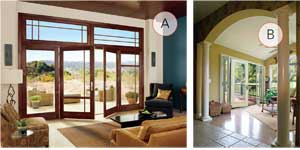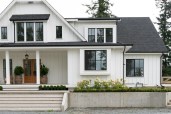How Low Can You Go?
Low or nearly invisible thresholds are also on the rise. In one project, McDonald embedded the door track in the substrate to remove the final small barrier to the outdoors. Weiland’s flush bottom track sits 3/16-inch above the finished floor, and the low sill on Pella’s new Architect Series hinged patio doors boasts water-blocking PerformaSeal Design to combat the biggest challenge inherent in low-sill construction. Water, however, is not the only unwelcome element.
“I don’t care who the manufacturer is, when you put a piece of glass into a wall you are creating a hole for heat and cooling loss,” says Lance Premeau, product and market analyst for Kolbe. However, new glass technology makes that loss a lot less, he adds. Low-E coatings, triple panes of glass, proper solar orientation, and region-specific glass improves the efficiency to where, in some cases, the R-value rivals a standard wall.
NanaWall Systems’ most recent addition is the NanaWall WA67. Designed for northern states, the aluminum-clad wood folding door filled with a foam layer and triple-glazed glass reaches an insulation value of R-6. With Ply Gem’s HP3MAX glass package, builders can upgrade select patio doors in the Premium, Pro, and Contractor Series 2000 in the eastern U.S and the Premium Series 1000 and Pro Series in the western U.S. to a triple-paned, argon-filled, door with low-E coatings for an R-5 rating. Passive solar heating also puts the big panels to work in cooler climates, says Nana Wall’s Thomas. With the right glass, sunlight warms the room and an interior low-E coating keeps the heat in.
Heavy Duty
Other than the added weight, big door systems are no more difficult to install than a regular patio door, McDonald claims, but he goes with the manufacturers’ certified installers because he found they can often do it for less than his own crew, and with NanaWall Systems, the warranty will double.
“We’ll install the easy stuff, but we’ll usually bring the certified guys out just because of the size of the panels,” he says.
Scott Denton of Denton Homes advises builders to know the type of door: swing, fold, stack, or lift-and-slide; how the structure will support the weight; and where the bulk of panels slide and store. “We’ve got an authorized installer who, from the time he shows up, in just a few hours has it put together, and if in a year I have any problems, they’ll come back and service it,” he says.
Premeau says Kolbe’s four-panel sliding door is easy enough to figure out from the instructions, but the lift-and-slides and the folding doors are trickier because the sill tracks must be level and plumb to the opening for the doors to operate smoothly. And one panel could weigh several hundred pounds. “A builder certainly can do it, but he may need some assistance for the very first time,” he says.
After putting a big door system in every home he has built in the last two years, McDonald has had practice and so have others.
“I don’t think you can find a higher-end modern home that doesn’t have big walls of glass,” he observes. “You’re going to see more and more of these disappearing walls.”
Three years ago, Oxnard, Calif., dealer Thurber knew of only a few manufacturers making larger doors. While there are many more now, the competition is still in its adolescence. “It’s been a really good margin sale for window and door dealers like us to help bring that margin back up in today’s volatile economy.”
And based on the crowds around the panels in his showroom, he says, “It’s just getting geared up.”


